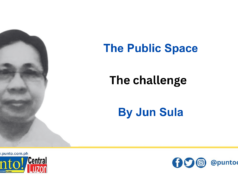THE PROPOSAL of the Clark International Airport and Corp. (CIAC) to build a stadium that can accommodate huge concerts, musical events and performances from international superstars such as Taylor Swift has raised more questions than approval from many Filipinos, including many a “Swiftie.”
While others may view it as the inability of many critics to see the bigger picture behind the proposed project, I see it as the renewed capability of a growing number of Filipinos to analyse how the government prioritizes its projects.
In a recent statement, CIAC president Arrey Perez confirmed that the plan to develop a 37-hectare Entertainment and Events Center in the Clark Civil Aviation Complex also includes a 150,000-square-meter international convention center, a mall that will house more than 300 stores, and an indoor sports arena that has a seating capacity of 30,000.
The stadium is also just one of the seven flagship projects of the CIAC. These include a $152-million, 60-hectare national food hub; a $30-million, 23-hectare urban renewal and heritage conservation program; a 3-hectare, new headquarters for the CIAC; and a 4,000-meter second runway for the Clark International Airport.
The project is estimated to cost more than P30 billion and Perez said that the CIAC is eyeing public-private partnership to finance the gargantuan undertaking. He also added that so far, a number of local and international companies have signified their intention to invest in the proposed project.
For the record, those who oppose this plan are not in any way against the construction of world-class and state-of-the-art facilities in the country. The questions are pretty simple. Is this what the country needs at a time when we have more pressing concerns and problems that have remained unattended for the longest time? Just a mere mention of the Filipino students’ dismal performance in the Programme for International Student Assessment (PISA) even prior to the pandemic is enough reason to put those billions of investments in education.
The list of government priorities is simply endless – the delivery of even the most basic health facilities and services in remote areas, the provision of modern facilities and sustainable, low-interest credit facilities for the country’s farmers and fisher folks, the improvement of the highly inefficient and unreliable public transport system, the construction of low-cost housing projects for the daily-wage earners, addressing the worsening peace-and-order situation that has become more evident even in key municipalities and urban areas, multi-sectorial and long-term solution to the incessant flooding problems in many coastal towns, and the modernization of the military most especially the Philippine navy as it continues to protect our country against all forms of aggressions from all external forces.
While the CIAC project aims to attract local and international tourists, other questions arise. How can the interest of these tourists be sustained if we cannot even assure them of a reliable transport system? How long can the public-private partnership recoup its investments if the government cannot ensure the regular staging of concerts and events? How can the government assure the ordinary Filipino taxpayer that this investment-heavy project will not be another white elephant in the making just like the P4-billion New Clark City Athletics Stadium complete with the now-infamous P50-million Cayetano cauldron?
I was discussing this project with some of my long-time friends over coffee when one blurted out desperately, “Juice-colored, magkano na naman kaya ing panakitan da reng makalukuk keng project ayan ay!”
Charge it to the Filipino brand of cynicism. But can we actually blame my friend or any Filipino for that matter if every single government project, whether in the national or barangay level, is always equated with corruption?





